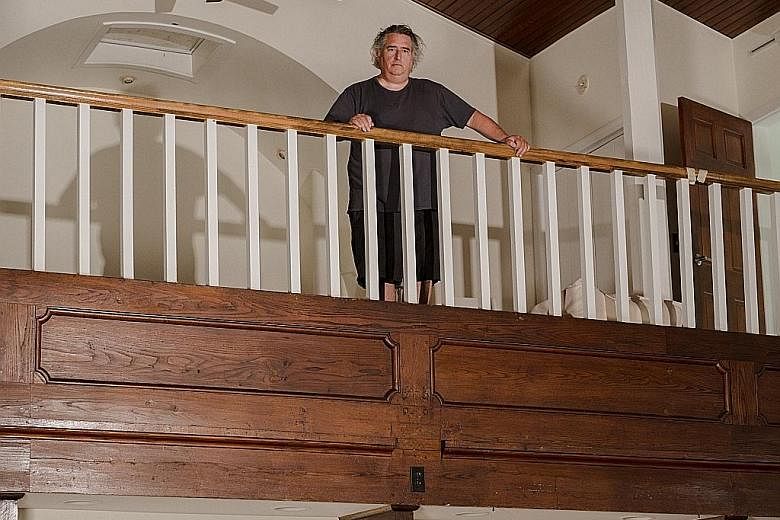MASSACHUSETTS • The world has caught up to Gregory Crewdson. In his large-scale photographs, which are produced with a movie crew in bravura Hollywood style, the people stare off into space, cloaked in solipsistic misery.
In the current locked-down world, his overwrought images seem like faithful representations of our frazzled psychological state.
"It's weird how all my pictures have taken on a new meaning," he said.
In a masked interview last month in his studio in Great Barrington, Massachusetts, he and Juliane Hiam, his studio manager and romantic partner, hung his prints, which are more than 2.1m wide and 1.2m high, one by one on the wall. It was the first studio visit since the pandemic lockdown in March and Crewdson, 57, a stocky, affable man, looked relaxed in a T-shirt and shorts.
His most recent body of work, a 16-photograph collection he calls An Eclipse Of Moths, will be presented next month at Gagosian in Beverly Hills and subsequently in Paris and New York.
He shot the pictures on the outskirts of Pittsfield, a depressed town 32.2km north of his home in the Berkshires. His central decision when he stages a photograph is selecting the site.
"I spend a lot of time driving around, finding locations that can accommodate a picture," Crewdson said, explaining the elaborate scouting procedure for his constructed images.
"Returning to these locations, a story will come into my head."
He then describes the concept to Hiam, who writes a scenario that will provide a template for the shoot.

"There's no motivation, no plot," he said. "I love the idea of creating a moment that has no before and after. I do everything I can to make it as powerful as possible."
The collection's name alludes to a term for a cluster of the nocturnal flying insects, which gather around an illumination source, eventually obscuring it. Embellishing his landscapes, he painted billboards and altered the street signs. He towed in dilapidated cars and installed an old telephone booth.

"We age everything," he said. "It should all look slightly broken. We work closely with the town. I asked them not to pave any streets, cut any grass. It's all in the effort of making a world that is beautiful and unsettling. I want it to feel both timeless and of the moment."
Everything appears to be outmoded, even the overhead electric wires. He shot An Eclipse Of Moths and previous sequences of Berkshires-based photographs during the summer, when the twilight is prolonged. Conveniently, he is off from his teaching duties at Yale, where he is director of graduate studies in photography.

The section of Pittsfield where he staged his pictures is near a General Electric transformer plant that poisoned the environment with polychlorinated biphenyls, but also employed most of the town. Hiam, who was born in Pittsfield, said: "My parents worked for GE. Everyone I knew had parents who came here for GE."
Pittsfield was devastated in 1987 by the closing of the factory, which now looms over the landscape like a ruined castle in a European village.
But Crewdson, who as a boy summered in a cabin in the nearby town of Becket with his Brooklyn-based family, sees the surroundings from a different vantage point.
"He definitely feels the area is enchanting," Hiam said. "It's the feeling a vacationer would have - the detached and enchanted view. When he takes me around to show his locations, I'm often not seeing what he is seeing yet."
Crewdson is a film-maker manque. "Almost from day one, I was interested in the intersection between movies and a still image," he said. "I love movies maybe above all forms of art - the dreamlike quality of going to a movie and watching the light on the screen and being intoxicated by how that world seems separate from our world. But I think in single images, always. I'm dyslexic and have trouble with linear storytelling."
Early in his career, in the mid 1990s, Crewdson created and photographed dioramas of out-of-scale insects and animals in natural settings that evoked the uncanny hothouse atmosphere of David Lynch's movie Blue Velvet (1986).
As he advanced, he employed actors and film crews to fabricate scenes with a similar emotional payoff on a grander scale.
During production, fog machines cloud the air and water trucks wet the streets. Lights beam down from 24m-high cranes. Unusually for a photographer, he employs a camera operator to press the shutter and a director of photography to arrange the lighting.
"I'm not comfortable holding the camera even," he said. "I'm interested in what I see in front of me."
NYTIMES

